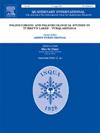Ethnic conflicts and their relationship with temperature change in the eastern Qinghai-Tibet Plateau and its vicinity during the past 2000 years
IF 1.9
3区 地球科学
Q3 GEOGRAPHY, PHYSICAL
引用次数: 0
Abstract
In the context of global warming, the study of climate change and its impacts has garnered significant attention. The Qinghai-Tibet Plateau, with its unique natural environment and socio-cultural significance, plays a crucial role in climate change and the development of the Chinese nation. Investigating the historical interactions, development, and socio-climatic background of the nomadic groups on the Qinghai-Tibet Plateau and agricultural ethnic groups in eastern China contributes to understanding the intrinsic mechanisms of how climate change affects the social interconnectivity of different ethnic groups. This paper is founded on an analysis of 450 conflict events between these groups, as reflected in ancient Chinese war chronicles and ethnic relations annals, creating a decadal conflict sequence from the Eastern Han to the Qing Dynasty (25AD-1910AD). The study conducts a correlation analysis and phase-wise statistical comparison between the climate research findings and the ethnic conflict sequence, specifically examining their relationship with temperature. The main findings are: (1) From the Eastern Han to the Qing Dynasty, a total of 876 conflicts occurred between the ethnic groups in the eastern Qinghai-Tibet Plateau and its vicinity (averaging 4.6 conflicts per decade), with 62.1% initiated by the Ethnic groups on the Qinghai-Tibet Plateau and 66.6% won by the Ethnic groups in eastern China; (2) The frequency of conflicts is primarily correlated with temperatures in the Eastern region, with a less distinct correlation in the Qinghai-Tibet Plateau. During overall warmer periods, conflict incidents were more frequent, with a higher proportion initiated by the Ethnic groups on the Qinghai-Tibet Plateau. Conversely, in colder periods, there were fewer conflicts, with an increased proportion initiated by the Ethnic groups in eastern China; (3) Unlike conflicts between the Ethnic groups in northwestern and eastern China, the Ethnic groups on the Qinghai-Tibet Plateau's external expansion was not a primary objective, indicating that the conflicts were mainly driven by regional economic strength and land productivity. The temperature can reduce land productivity by limiting the growth potential of crops and livestock or by reducing the advance to restrict their production. As a result, water resources, as a condition of land productivity variation, and climate became significant backgrounds for ethnic interactions.
过去 2000 年青藏高原东部及其附近地区的民族冲突及其与气温变化的关系
在全球气候变暖的背景下,气候变化及其影响的研究备受关注。青藏高原以其独特的自然环境和社会文化意义,在气候变化和中华民族的发展中发挥着至关重要的作用。研究青藏高原游牧民族与中国东部农业民族的历史互动、发展和社会气候背景,有助于理解气候变化如何影响不同民族社会相互联系的内在机制。本文基于对中国古代战争编年史和民族关系年鉴中反映的 450 起族群间冲突事件的分析,建立了从东汉到清代(公元 25 年-1910 年)的十年冲突序列。本研究对气候研究成果和民族冲突序列进行了相关分析和分期统计比较,特别是考察了它们与气温的关系。主要发现有(1)从东汉到清代,青藏高原东部及其附近地区的民族冲突共发生 876 次(平均每十年 4.6 次),其中 62.1%的冲突由青藏高原上的民族发起,66.6%的冲突由华东地区的民族获胜;(2)冲突发生的频率主要与华东地区的气温相关,青藏高原的相关性不明显。在总体气温较高的时期,冲突事件更为频繁,青藏高原民族群体引发冲突的比例较高。相反,在气温较低的时期,冲突事件较少,而由中国东部民族发起的冲突事件比例增加;(3)与中国西北部和东部民族之间的冲突不同,青藏高原民族对外扩张不是主要目的,这表明冲突主要是由地区经济实力和土地生产力所驱动的。气温会限制农作物和牲畜的生长潜力,或减少前进限制其生产,从而降低土地生产力。因此,作为土地生产力变化条件的水资源和气候成为民族互动的重要背景。
本文章由计算机程序翻译,如有差异,请以英文原文为准。
求助全文
约1分钟内获得全文
求助全文
来源期刊

Quaternary International
地学-地球科学综合
CiteScore
5.60
自引率
4.50%
发文量
336
审稿时长
3 months
期刊介绍:
Quaternary International is the official journal of the International Union for Quaternary Research. The objectives are to publish a high quality scientific journal under the auspices of the premier Quaternary association that reflects the interdisciplinary nature of INQUA and records recent advances in Quaternary science that appeal to a wide audience.
This series will encompass all the full spectrum of the physical and natural sciences that are commonly employed in solving Quaternary problems. The policy is to publish peer refereed collected research papers from symposia, workshops and meetings sponsored by INQUA. In addition, other organizations may request publication of their collected works pertaining to the Quaternary.
 求助内容:
求助内容: 应助结果提醒方式:
应助结果提醒方式:


